Mammals are the most varied group of vertebrates with such diverse members as bats, whales, dogs, duck billed platypuses and elephants to name but a few. The defining characteristic of mammals is that they feed their young on milk produced by the mother which means that the young can be nourished and protected for extended lengths of time after birth.
Mammalia - Mammals
The mammals are the most familiar of all animal groups, ask someone to name 10 animals and the chances are many if not all of them will be mammals, though they probably won't name the most obvious animal of all - humans.
Typical Mammals
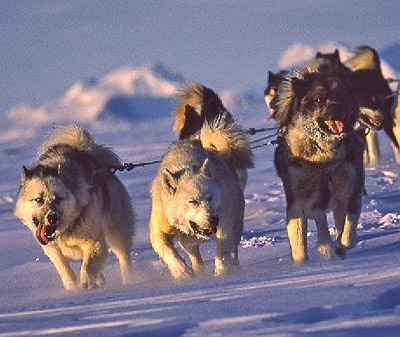
Domestic dogs, Canis lupus familiaris
- Carnivora. Huskies in Antarctica here. A
sub-species of wolves, dogs are probably the most varied
of any animal species, think of a Great Dane, Chihuahua,
Dalmatian and Pug for instance, and no-one really knows
why.

House mouse, Mus musculus
- Rodentia. An originally wild animal that has
lived closely with man for thousands of years. Used
extensively in research, it is one of the few animals
to have its entire genome sequenced.
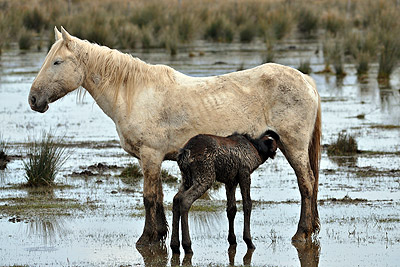
Horse, Equus ferus caballus
- Perissodactyla. This is a wild horse and foal,
part of the domesticated subspecies caballus
that has secondarily become wild again. Here demonstrating
one of the main advantages of the mammalian way of life,
the production of milk from mammary glands allowing
extensive care and nourishment of the young following
birth.
Photo: Alberto g
rovi. CC3 Attribution ShareAlike License
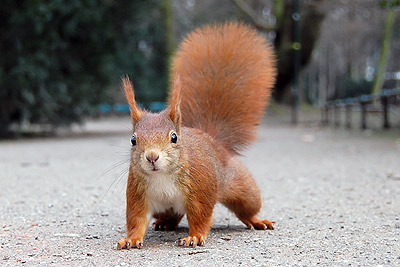
Red squirrel, Sciurus vulgaris
- Rodentia. Most mammal species are fairly small
it's just that we notice the big ones more, some are
more charismatic than others however as Squirrel Nutkin
here demonstrates.
Photo:
Ray eye.CC2 Attribution ShareAlike License Germany
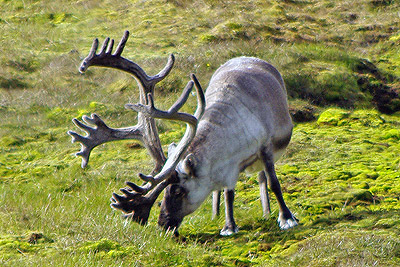
Reindeer, Rangifer tarandus
- Artiodactyla. Like other deer they regrow
their bony antlers each year. The males have large antlers
for display to each other and to females as a way of
competing for mates. Large antlers provide a good way
to measure the health and fitness of a male able to
perform this challenging physiological feat on an annual
basis.
Cool Mammals
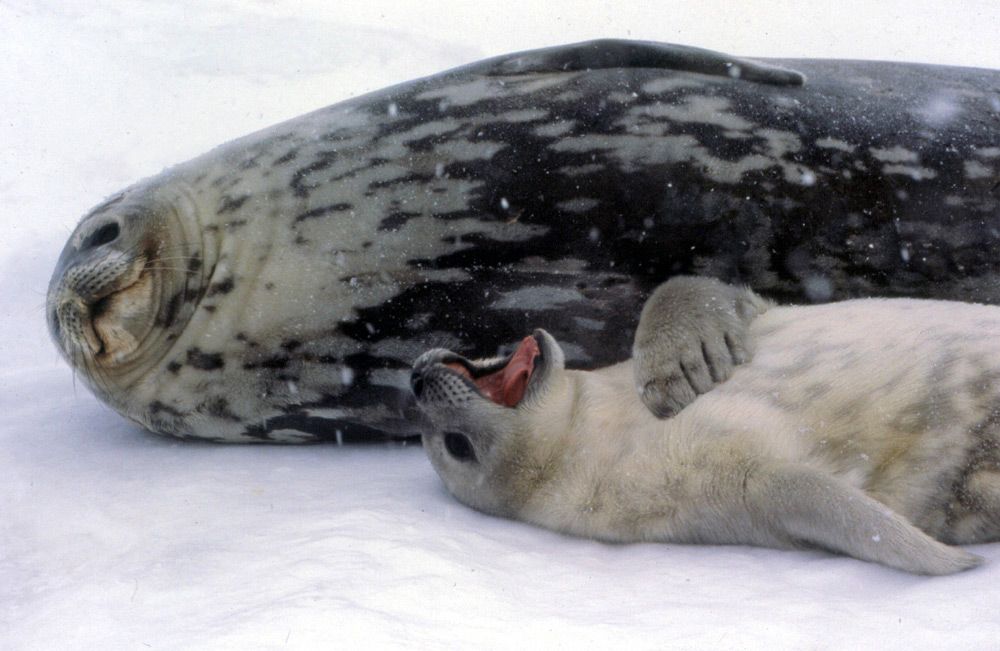
Weddell Seal, Leptonychotes
weddellii - Carnivora. Using all of the
mammal characters to the full. Pregnant female Weddell
seals haul out onto Antarctic sea-ice where they can
live actively due to generating their own heat. They
give birth to a pup which they feed with some of the
most nourishing milk in the world at 60% fat. The pup
is protected by the most effective insulation in the
animal kingdom - fur.
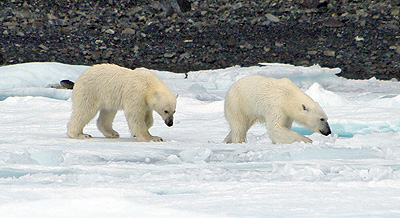
Polar bear, Ursus maritimus
- Carnivora. The largest land predator of all,
uniquely and supremely adapted for a life spent hunting
seals on sea-ice against a snowy and icy back drop.
These are probably two young siblings a couple of years
or so old.

Humans, Homo sapiens -
Primates. The most numerous large mammals on the
planet. Defined as much as anything by a constant need
to communicate, dance, display and more recently photograph
the whole process and show each other, as here.

Flying Fox, Pteropus vampyrus - Chiroptera.
Bats have many unique adaptations on the basic mammalian
plan, but all of the elements are there. See those wings?
They're covered in skin very like yours and the bones
in the arms, hands and fingers match up to the same
bones that you have.

Blue whale, Balaenoptera
musculus - Cetacea.
The largest animal
ever to have lived, larger than the biggest dinosaur.
A baleen whale with teeth replaced with baleen plates,
sometimes known as "whalebone", though not bone at all,
made from keratin as are hair and fingernails and hooves.
They can weigh 100 tons and even more, in the peak of
their feeding season in the Antarctic Ocean, they can
eat 4 tons of food a day.
Videos
Life of Mammals, BBC on Youtube
Humpback whales feeding on krill - "bubble-netting"
Mother polar bear and cubs emerging from
their winter den
Kingdom - Animalia
Phylum - Chordata
Subphylum - Vertebrata
Class - Mammalia
Basic Features:
Mammals are a Class in the Subphylum
Vertebrata of
the Phylum Chordata, so they have all of the characteristics
of both of these groups in addition to the following:
- Waterproof skin with hair or fur.
- Endothermic, warm blooded.
- Give birth to live young.
- The young are supplied with milk from mammary glands by the mother(from which the group gets their name).
- Three middle ear bones.
- Heterodont dentition, different types of teeth.
What do mammals eat?
There are about 5,500 mammal species so far described and between them, they eat just about everything they can lay their jaws on. Some are very specialized such as anteaters, others will eat anything and everything as do rats. Here are a few notable dining preferences.
Grass - most mammals by sheer numbers are herbivores and many mammalian herbivores eat grass. Grass is tough stuff to deal with and takes time to digest and most non-mammals just can't deal with it. Mammals have a perfect combination of large size and a warm body temperature to enable them to handle eating grass. It takes time to ferment the tough leaves and stems and break down the compounds that are there for the taking if you can get at them. As it happens mammals can't actually do this themselves, they need a gut fauna of bacteria to do it for them. They start with strong grinding teeth and jaw muscles and then move on to complex and/or long digestive systems that create a perfect place for the bacteria to grow to work on the grass for long enough to break it down. Cattle, deer, sheep, goats, rabbits, antelope, gazelle, horses and a whole host of other mammals just love grass!
Other tough plant material such as leaves, and bark, plant shoots and twigs. For the same reason and in the same way as they can eat grass, many mammals can tackle even tougher stuff too. Goats, giraffes and elephants for instance can get nutrition from materials that most animals would get next to nothing from at all.
Insects:
- Bats in particular like to
eat insects. Some small bats can eat about 1,000
mosquitoes an hour in the summer. Bats can get through
50-100% of their body weight in insects in a night.
There is a place in Texas called Bracken Cave where
30 million Mexican free-tailed bats live, between
them they get though around 250 tons of insects
a night in summer. Bats will however catch and eat
just about any flying insect they can get, moths,
flies, beetles etc.
- Anteaters, armadillos, pangolins, echidnas
and aardvarks are specialist eaters of
ants and termites.
- Humans - insects are regarded as a delicacy in some parts of the world, flying ants in many parts of Africa and many kinds of insects in S.E. Asia.
Krill - this small Antarctic crustacean related to and looking like a swimming shrimp is one of the most populous animals by numbers and weight on earth. It is the staple food of the mis-named crabeater seal which is the second most numerous large mammal on earth after man. It is also eaten in huge quantities by the great whales, at the rate of 3-4 tonnes a day by a single large blue whale in the Antarctic summer for instance. When the whales were decimated by hunting, the population of Antarctic Fur Seals increased around the island of South Georgia to a current level of around 4 million
Other mammals - we've all seen hunting scenes on wildlife documentaries by wolves, polar bears, lions, tigers and other big cats and in the main they are hunting other mammals whether they be deer, antelope, seals or just anything smaller than they are that has happened to catch their eye.
What eats mammals?
If you're a small mammal such as a mouse, lemming, or rabbit, then just about any carnivore that is bigger than you will try to eat you. This may be another mammal such as a member of the cat or dog families or a bird of prey, many of which eat small mammals exclusively or opportunistically.
Even if you're quite a large mammal such as a deer, antelope, giraffe, buffalo or wildebeest, other mammals such as large pack hunting members of the cat and dog families but also bears depending on where you live. It is almost entirely the young or old or infirm that are hunted and killed in this way, large adult mammals in good condition can usually run away or protect themselves from predators. An adult giraffe or zebra can kill or maim a adult lion with a single kick for instance.
Even large whales are not immune, killer whales or Orcas will chase young whales or elderly or sick adults of much larger species. They kill them by biting the huge tongue which leads to the whale bleeding to death, sometimes the rest of the whale is left to sink and only the tongue is eaten.
Polar bears - feed by preference on seals that they catch on the sea ice.
Many snakes target mammals. Snakes can see in infra-red as they are cold blooded, this gives them a night vision to spot and attack small mammals many of which are nocturnal.
Man - of course, many of our favourite foods are mammals, especially beef, pork and lamb.
The group includes:
Like most groups of living things, the status of mammal groups, whether they are Classes, Orders, infraorders, subclasses etc. is something that is currently changing and somewhat confusing as to what they should be called. I have named some of the major groups without saying which level the group is (class, order, etc.) as doubtless the hierarchy will change whereas the names are relatively constant. The following list is representative but not complete:
The most primitive of the mammals, represented by 5 species that lay eggs with leathery shells and feed the young on milk produced from mammary glands though with no nipple, the young lap it up from the skin surface. Duck-billed platypus, Echidnas (spiny anteaters)
Around 330 species of mammals, the young are born at an early immature stage and continued development happens in an external pouch in most species. Opossums, numbats, bandicoots, kangaroos, wallabies, wombats, koala bears.
- Artiodactyla - Even-toed ungulates
(hoofed animals), the weight is carried almost equally
on the third and fourth toes which allows them to
traverse uneven surfaces - pigs, cattle,
sheep, goats, deer, antelopes, giraffes, hippos.
- Carnivora - Carnivores, though
mammals in other groups can be carnivores too. Land
animals in the main with prominent canine teeth
and carnassial teeth for shearing meat, usually
powerful sharp claws. - wolves, dogs, foxes,
cats, bears, skunks, badgers, seals, otters
- Cetacea - Marine mammals including
all whales, dolphins and porpoises.
Evolved about 50 million years ago from land animals.
The most adapted of all mammals for living in water
and amongst the most intelligent of all animals.
- Chiroptera - Bats. The only
mammals that are active fliers capable of sustained
true flight rather than simply gliding. The arm
and fingers are developed into a frame-work to carry
a skin membrane. About 20% of all mammal species
are bats. They are surprisingly slow breeders and
long lived for their size, mainly having one offspring
a year and living for 5-6 years, even up 30-40 years
if they are lucky - fruit bat, vampire
bat, flying fox, pipistrelle.
- Edentata (Xenarthra) - A group
only found today in the Americas, there were a number
of giant members of the group that are now all extinct
- anteaters, sloths, armadillos.
- Hyracoidea - Hyraxes. A small
group of 4 species that look quite like rodents
about 2-5kg in weight though are more closely related
to elephants.
- Lagomorpha - An almost exclusively
herbivorous group with an unusual double-digestion
where food is initially fermented in a part of the
gut called the caecum, then voided as moist pellets
which are immediately eaten again, after the second
time through they are voided as dry pellets -
rabbits, hares, pikas.
- Macroscelidea - elephant shrews.
Small very active insectivorous mammals with elongated
snouts.
- Perissodactyla - Odd-toed ungulates
(hooved animals) the middle toe on each hind limb
is usually the largest, the others may be much smaller
or even absent altogether - horses, rhinos,
tapirs.
- Pholidota - Scaly anteater
or pangolin. Uniquely covered in
overlapping keratin scales that it uses as armour
when threatened and rolls up into a ball.
- Primates - A group that originally
evolved as tree-dwellers, some members then came
down onto the ground, most species spend at least
some part of their lives in trees. Opposable thumbs
and prehensile tails in some species. Vision is
the main sense at the expense of smell. Relatively
slow reproductive rates but longer lifespans -
baboons, gibbons, apes (no tail) humans,
lemurs, monkeys (with a tail).
- Proboscidea - Trunked animals,
more numerous and varied species in the past, just
three surviving species today - African
elephant ttwo species-maybe), Indian
elephant.
- Rodentia - The largest of the
mammal groups with around 40% of species. Defined
by having a pair of incisor teeth in each jaw that
grow continually and must be kept short by gnawing.
Generally small animals often with highly developed
social behaviour. Mainly herbivorous or omnivorous
- mice, rats, squirrels, beavers,
porcupines, gerbils, hamsters, guinea pigs.
- Sirenia - Fully aquatic herbivores
of rivers, lakes and sheltered coastal waters. The
forelimbs are paddle-like and the tail is a paddle
for propulsion, the hind limbs have degenerated
- dugongs, manatees.
Mammalian limbs have the same bones in the same order, though in different proportion. They are put to different uses by different species, here are seven examples. For instance, horses run on the equivalent of their middle fingers, whereas pigs walk on two fingers and the fingers of bats are similar in length to the rest of their arm. The bone called the third meta carpal or meta tarsal (carpal forelimb, tarsal hindlimb) is shown in red for each limb.
Graphic: Jerry Crimson Mann. published under Creative Commons Attribution ShareAlike 3.0 Unported License.
Top banner picture - Asian elephants in Kui Buri National Park Thailnad, courtesy KOSIN SUKHUM used under CC4 Attribution Share Alike International license.

